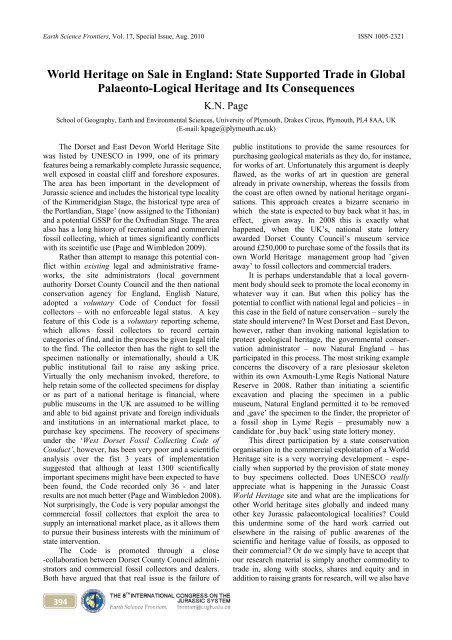in Jurassic and Cretaceous Stratigraphy
in Jurassic and Cretaceous Stratigraphy
in Jurassic and Cretaceous Stratigraphy
Create successful ePaper yourself
Turn your PDF publications into a flip-book with our unique Google optimized e-Paper software.
Earth Science Frontiers, Vol. 17, Special Issue, Aug. 2010 ISSN 1005-2321<br />
World Heritage on Sale <strong>in</strong> Engl<strong>and</strong>: State Supported Trade <strong>in</strong> Global<br />
Palaeonto-Logical Heritage <strong>and</strong> Its Consequences<br />
394<br />
K.N. Page<br />
School of Geography, Earth <strong>and</strong> Environmental Sciences, University of Plymouth, Drakes Circus, Plymouth, PL4 8AA, UK<br />
(E-mail: kpage@plymouth.ac.uk)<br />
The Dorset <strong>and</strong> East Devon World Heritage Site<br />
was listed by UNESCO <strong>in</strong> 1999, one of its primary<br />
features be<strong>in</strong>g a remarkably complete <strong>Jurassic</strong> sequence,<br />
well exposed <strong>in</strong> coastal cliff <strong>and</strong> foreshore exposures.<br />
The area has been important <strong>in</strong> the development of<br />
<strong>Jurassic</strong> science <strong>and</strong> <strong>in</strong>cludes the historical type locality<br />
of the Kimmeridgian Stage, the historical type area of<br />
the Portl<strong>and</strong>ian‚ Stage’ (now assigned to the Tithonian)<br />
<strong>and</strong> a potential GSSP for the Oxfrodian Stage. The area<br />
also has a long history of recreational <strong>and</strong> commercial<br />
fossil collect<strong>in</strong>g, which at times significantly conflicts<br />
with its sce<strong>in</strong>tific use (Page <strong>and</strong> Wimbledon 2009).<br />
Rather than attempt to manage this potential con-<br />
flict with<strong>in</strong> exist<strong>in</strong>g legal <strong>and</strong> adm<strong>in</strong>istrative frame-<br />
works, the site adm<strong>in</strong>istrators (local government<br />
authority Dorset County Council <strong>and</strong> the then national<br />
conservation agency for Engl<strong>and</strong>, English Nature,<br />
adopted a voluntary Code of Conduct for fossil<br />
collectors – with no enforceable legal status. A key<br />
feature of this Code is a voluntary report<strong>in</strong>g scheme,<br />
which allows fossil collectors to record certa<strong>in</strong><br />
categories of f<strong>in</strong>d, <strong>and</strong> <strong>in</strong> the process be given legal title<br />
to the f<strong>in</strong>d. The collector then has the right to sell the<br />
specimen nationally or <strong>in</strong>ternationally, should a UK<br />
public <strong>in</strong>stitutional fail to raise any ask<strong>in</strong>g price.<br />
Virtually the only mechanism <strong>in</strong>voked, therefore, to<br />
help reta<strong>in</strong> some of the collected specimens for display<br />
or as part of a national heritage is f<strong>in</strong>ancial, where<br />
public museums <strong>in</strong> the UK are assumed to be will<strong>in</strong>g<br />
<strong>and</strong> able to bid aga<strong>in</strong>st private <strong>and</strong> foreign <strong>in</strong>dividuals<br />
<strong>and</strong> <strong>in</strong>stitutions <strong>in</strong> an <strong>in</strong>ternational market place, to<br />
purchase key specimens. The recovery of specimens<br />
under the ‘West Dorset Fossil Collect<strong>in</strong>g Code of<br />
Conduct’, however, has been very poor <strong>and</strong> a scientific<br />
analysis over the fist 3 years of implementation<br />
suggested that although at least 1300 scientifically<br />
important specimens might have been expected to have<br />
been found, the Code recorded only 36 - <strong>and</strong> later<br />
results are not much better (Page <strong>and</strong> Wimbledon 2008).<br />
Not surpris<strong>in</strong>gly, the Code is very popular amongst the<br />
commercial fossil collectors that exploit the area to<br />
supply an <strong>in</strong>ternational market place, as it allows them<br />
to pursue their bus<strong>in</strong>ess <strong>in</strong>terests with the m<strong>in</strong>imum of<br />
state <strong>in</strong>tervention.<br />
The Code is promoted through a close<br />
-collaboration between Dorset County Council adm<strong>in</strong>i-<br />
strators <strong>and</strong> commercial fossil collectors <strong>and</strong> dealers.<br />
Both have argued that that real issue is the failure of<br />
public <strong>in</strong>stitutions to provide the same resources for<br />
purchas<strong>in</strong>g geological materials as they do, for <strong>in</strong>stance,<br />
for works of art. Unfortunately this argument is deeply<br />
flawed, as the works of art <strong>in</strong> question are general<br />
already <strong>in</strong> private ownership, whereas the fossils from<br />
the coast are often owned by national heritage organi-<br />
sations. This approach creates a bizarre scenario <strong>in</strong><br />
which the state is expected to buy back what it has, <strong>in</strong><br />
effect, given away. In 2008 this is exactly what<br />
happened, when the UK’s, national state lottery<br />
awarded Dorset County Council’s museum service<br />
around £250,000 to purchase some of the fossils that its<br />
own World Heritage management group had ’given<br />
away’ to fossil collectors <strong>and</strong> commercial traders.<br />
It is perhaps underst<strong>and</strong>able that a local govern-<br />
ment body should seek to promote the local economy <strong>in</strong><br />
whatever way it can. But when this policy has the<br />
potential to conflict with national legal <strong>and</strong> policies – <strong>in</strong><br />
this case <strong>in</strong> the field of nature conservation – surely the<br />
state should <strong>in</strong>tervene? In West Dorset <strong>and</strong> East Devon,<br />
however, rather than <strong>in</strong>vok<strong>in</strong>g national legislation to<br />
protect geological heritage, the governmental conser-<br />
vation adm<strong>in</strong>istrator – now Natural Engl<strong>and</strong> – has<br />
participated <strong>in</strong> this process. The most strik<strong>in</strong>g example<br />
concerns the discovery of a rare plesiosaur skeleton<br />
with<strong>in</strong> its own Axmouth-Lyme Regis National Nature<br />
Reserve <strong>in</strong> 2008. Rather than <strong>in</strong>itiat<strong>in</strong>g a scientific<br />
excavation <strong>and</strong> plac<strong>in</strong>g the specimen <strong>in</strong> a public<br />
museum, Natural Engl<strong>and</strong> permitted it to be removed<br />
<strong>and</strong> ‚gave’ the specimen to the f<strong>in</strong>der, the proprietor of<br />
a fossil shop <strong>in</strong> Lyme Regis – presumably now a<br />
c<strong>and</strong>idate for ‚buy back’ us<strong>in</strong>g state lottery money.<br />
This direct participation by a state conservation<br />
organisation <strong>in</strong> the commercial exploitation of a World<br />
Heritage site is a very worry<strong>in</strong>g development – espe-<br />
cially when supported by the provision of state money<br />
to buy specimens collected. Does UNESCO really<br />
appreciate what is happen<strong>in</strong>g <strong>in</strong> the <strong>Jurassic</strong> Coast<br />
World Heritage site <strong>and</strong> what are the implications for<br />
other World heritage sites globally <strong>and</strong> <strong>in</strong>deed many<br />
other key <strong>Jurassic</strong> palaeontological localities? Could<br />
this underm<strong>in</strong>e some of the hard work carried out<br />
elsewhere <strong>in</strong> the rais<strong>in</strong>g of public awarenes of the<br />
scientific <strong>and</strong> heritage value of fossils, as opposed to<br />
their commercial? Or do we simply have to accept that<br />
our research material is simply another commodity to<br />
trade <strong>in</strong>, along with stocks, shares <strong>and</strong> equity <strong>and</strong> <strong>in</strong><br />
addition to rais<strong>in</strong>g grants for research, will we also have

















